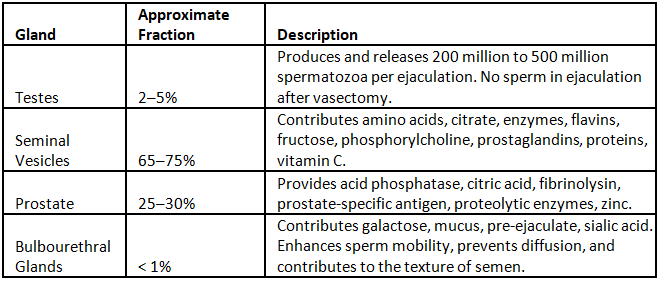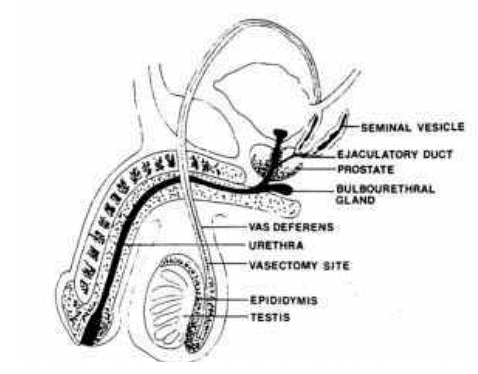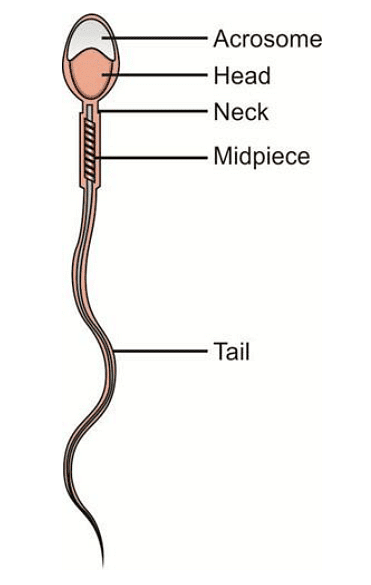UPSC Exam > UPSC Notes > Zoology Optional Notes for UPSC > Composition of Semen
Composition of Semen | Zoology Optional Notes for UPSC PDF Download
Composition of Semen
Semen, a substance produced by male reproductive organs, is a combination of spermatozoa in a semi-viscous fluid.
Various structures within the male reproductive tract contribute to semen production:
- Testes and Epididymis: Responsible for the production and maturation of spermatozoa. The testes also produce testosterone and inhibin.
- Prostate: Contributes approximately 20% of semen volume, providing fluids containing acid phosphatase and proteolytic enzymes that lead to coagulation.
- Seminal Vesicles: Contribute around 70% of semen volume and are the source of fructose, which serves as an energy source for spermatozoa.
- Bulbourethral Gland: Also plays a role in semen production.
Semen is the result of the combined secretions from these different regions, with each fraction having a distinct chemical composition and function.
The ultimate purpose of this combination during ejaculation is to create an optimal environment for transporting sperm to the endocervical mucus in females.
The components and contributions of semen are as follows:



The document Composition of Semen | Zoology Optional Notes for UPSC is a part of the UPSC Course Zoology Optional Notes for UPSC.
All you need of UPSC at this link: UPSC
|
198 videos|351 docs
|
FAQs on Composition of Semen - Zoology Optional Notes for UPSC
| 1. What is the composition of semen? |  |
Ans. Semen is a fluid that is ejaculated during sexual intercourse or through masturbation. It is composed of various substances, including sperm cells, seminal fluid, and other components. The composition of semen typically includes spermatozoa (sperm cells), fructose (a sugar that provides energy for the sperm), enzymes, prostaglandins (hormone-like substances that help in sperm motility), citric acid (which helps with sperm viability), and various proteins and minerals.
| 2. What is the role of spermatozoa in semen? |  |
Ans. Spermatozoa, or sperm cells, are the main component of semen. Their primary function is to fertilize the female egg and initiate the process of reproduction. Spermatozoa are produced in the testes and stored in the epididymis until ejaculation. When semen is ejaculated, the spermatozoa swim towards the female reproductive tract in search of an egg. Only a small fraction of the millions of sperm cells in semen reach the egg, and if successful, one sperm cell penetrates the egg to fertilize it.
| 3. What is the significance of fructose in semen? |  |
Ans. Fructose is a type of sugar found in semen, and its main role is to provide energy for the sperm cells. Spermatozoa need a constant supply of energy to swim and survive in the female reproductive tract. Fructose acts as a fuel source for the sperm, allowing them to maintain their motility and vitality during their journey towards the egg. Without sufficient fructose, the sperm cells may not have enough energy to reach and fertilize the egg.
| 4. How do enzymes in semen contribute to fertility? |  |
Ans. Semen contains various enzymes that play a crucial role in fertility. These enzymes help to liquefy the semen after ejaculation, allowing the spermatozoa to move freely. One such enzyme is called prostate-specific antigen (PSA), which helps to break down the proteins in semen and promote its liquefaction. This process is important for the sperm cells to swim effectively and reach the egg for fertilization. Additionally, other enzymes in semen help in the process of sperm capacitation, which is necessary for the sperm to acquire the ability to fertilize an egg.
| 5. What are prostaglandins in semen and their function? |  |
Ans. Prostaglandins are hormone-like substances found in semen. They have various functions, including promoting sperm motility and aiding in the process of fertilization. Prostaglandins help to stimulate the contractions of the female reproductive tract, which assists in the movement of sperm towards the egg. They also play a role in the immune response of the female reproductive system, helping to prevent the rejection of sperm by the female body. Overall, prostaglandins contribute to the success of fertilization by enhancing sperm movement and survival within the female reproductive tract.
Related Searches





















